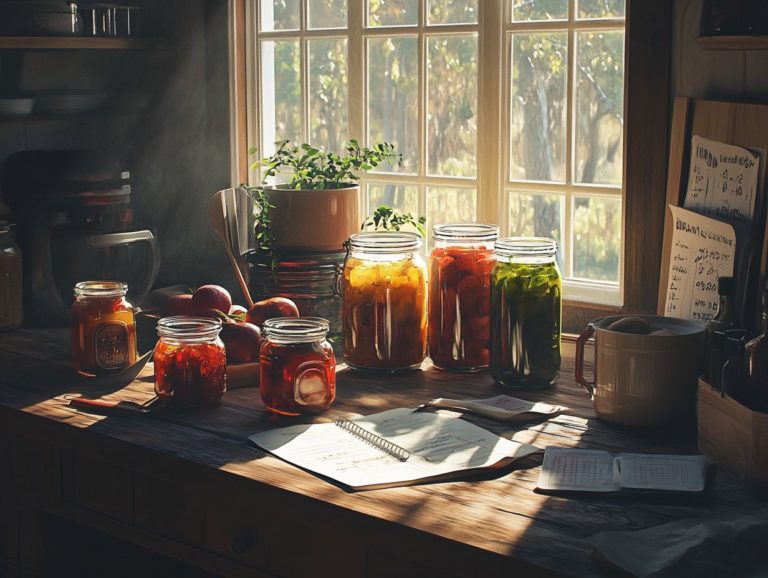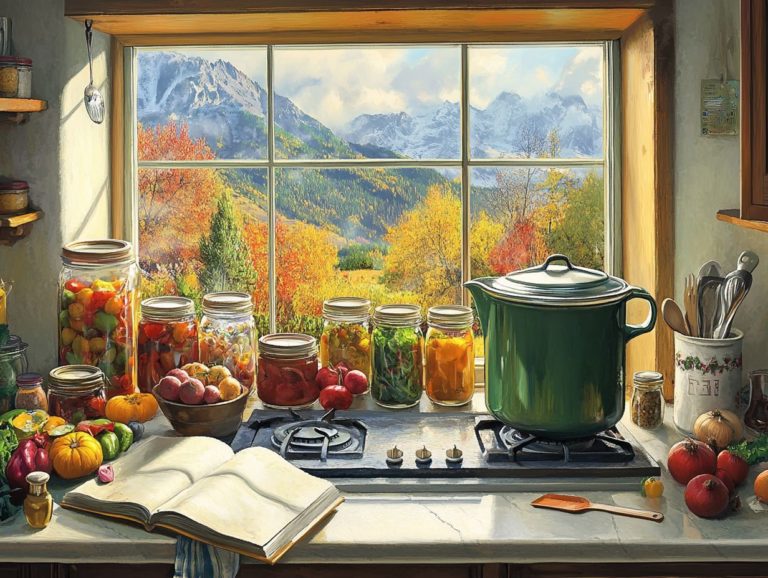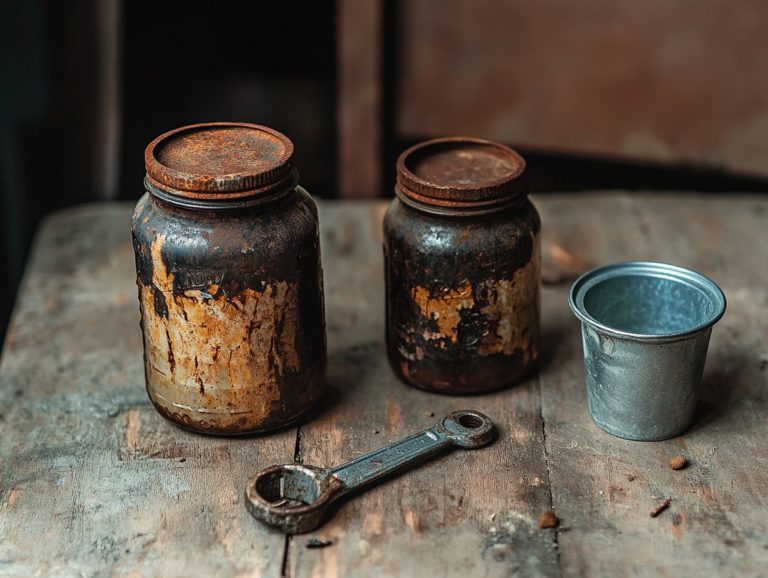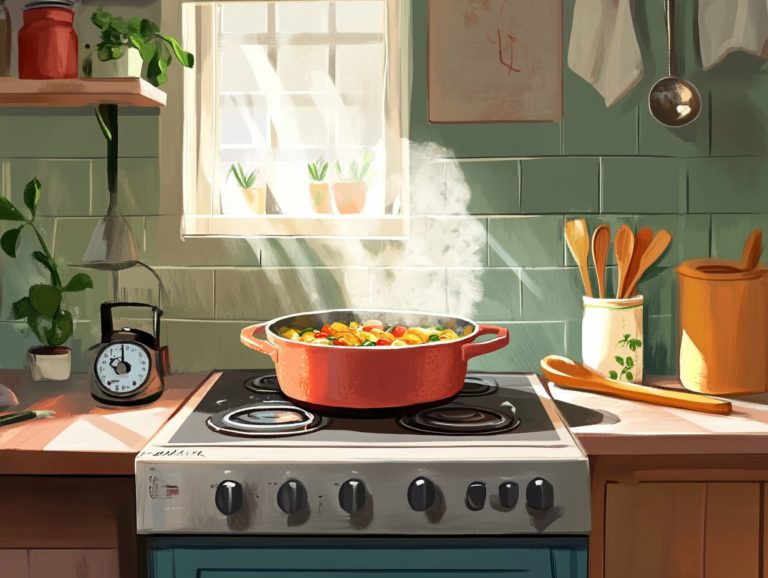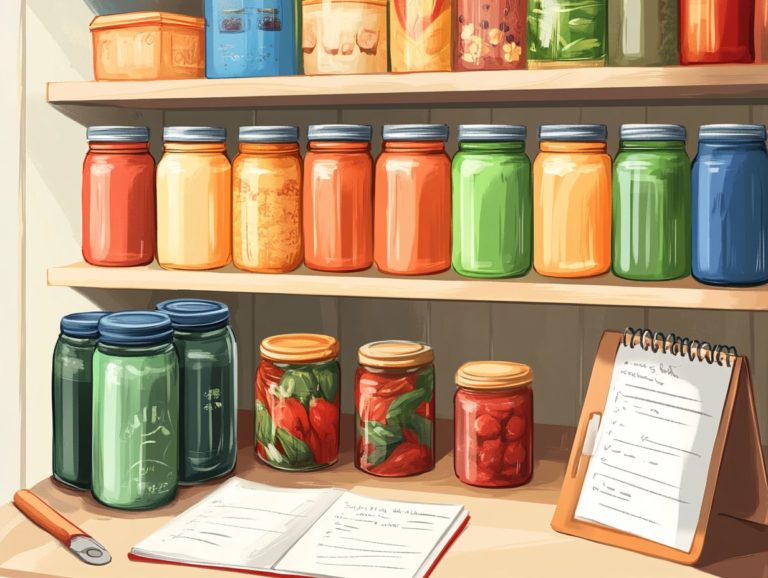Canning Liquid Evaporation: Causes and Fixes
Canning offers a remarkable method for preserving food, yet many home canners encounter the common challenge of liquid evaporation. Grasping the factors behind this evaporation is essential for safeguarding the quality and safety of your canned goods.
This article delves into the implications of canning liquid evaporation, outlines preventive measures, and presents effective solutions should you face this issue. It also explores alternative canning methods to help you achieve optimal results.
Dive into this guide and enhance your canning skills!
Contents
- Key Takeaways:
- Understanding Canning Liquid Evaporation
- Effects of Canning Liquid Evaporation
- Preventing Canning Liquid Evaporation
- Fixing Canning Liquid Evaporation
- Alternative Canning Methods
- Frequently Asked Questions
- What causes liquid to evaporate during the canning process?
- Can I prevent liquid loss during canning?
- How much headspace should I leave in a jar to prevent liquid loss?
- What can I do if my canning jars have lost too much liquid during the process?
- How can I fix a jar that has lost liquid after processing?
- Can I reuse jars that have lost liquid during canning?
Key Takeaways:
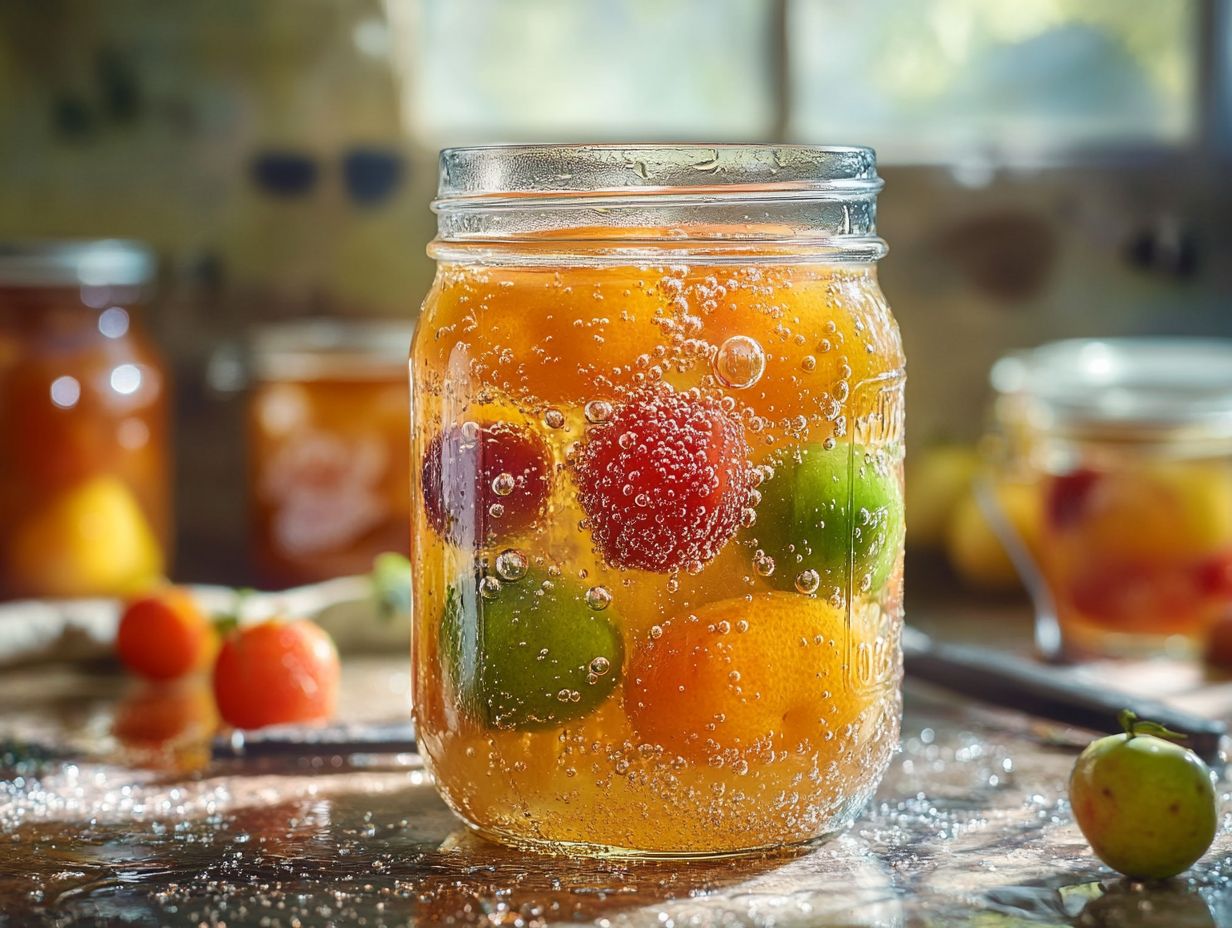
- Proper canning techniques and tips can help prevent liquid evaporation, maintaining food quality and safety.
- Canning liquid evaporation can affect food quality and safety, so understanding its causes and effects is important for successful preservation.
- If liquid evaporation occurs during canning, steps can be taken to fix it and salvage the food, or alternative canning methods can be explored.
Understanding Canning Liquid Evaporation
Understanding the evaporation of canning liquid is crucial for those who wish to preserve the quality of their food at home. This process involves several factors, such as the space at the top of the jar, which accommodates changes in pressure during the canning process, and avoiding common canning mistakes can help ensure successful results.
Liquid loss can occur if cooling is mishandled or if there are temperature changes in your canning environment, ultimately compromising the storage conditions in your pantry or garden.
By understanding these details, you can ensure food safety and improve your canning experience, extending the longevity of your home-canned vegetables and fruits.
What Causes Canning Liquid to Evaporate?
Canning liquid can evaporate for various reasons, including temperature changes and changes in pressure during the canning process. If you encounter issues, consider troubleshooting excessive canning liquid for effective solutions.
Trapped air bubbles inside hot jars can significantly contribute to this liquid loss. When you fill and seal the jars, any remaining air can form bubbles, especially at elevated temperatures, which leads to increased evaporation rates. For instance, if you process jars at a temperature that’s too high, the steam escapes, often taking some liquid with it. To avoid such issues, refer to troubleshooting common canning problems, especially in methods like hot water bath canning, where maintaining a consistent temperature is vital.
If you don’t control the temperature properly, it can worsen evaporation, resulting in an undesirable reduction in liquid levels that may compromise the overall quality and safety of your preserved contents.
Effects of Canning Liquid Evaporation
The impact of canning liquid evaporation on food quality and safety is profound, presenting potential risks in canned goods. When the liquid levels diminish, the preservation of the food may be compromised. To mitigate these issues, consider troubleshooting your canning process to heighten the likelihood of avoiding spoilage and the emergence of harmful bacteria, such as botulism.
Moreover, evaporation can affect the texture, color, and flavor of canned foods, which is a particular concern when preserving fresh produce or homemade fruit syrups. It’s essential to be aware of these factors to ensure your home-canned goods are both safe and delightful.
How Does it Affect Food Quality and Safety?

The impact of liquid evaporation on food quality and safety is significant, potentially leading to issues like improper cooling and an increased risk of botulism in canned foods.
When liquids evaporate during the canning process, they create a vacuum that might not adequately prevent the growth of harmful microorganisms. This can compromise the safety of your home-canned goods, making it essential for you to grasp the intricacies of food preservation.
Adhering to established food safety standards is critical; improper canning practices can lead to spoilage or unsafe products that pose serious health risks. By following recommended guidelines, you can significantly reduce these risks, ensuring that your home-canned items remain safe, nutritious, and a delight to consume.
Preventing Canning Liquid Evaporation
Preventing the evaporation of canning liquid is essential for preserving the longevity and quality of your home-canned goods. Follow proper procedures and effective canning techniques to achieve this.
Techniques like water bath canning and pressure canning are invaluable in maintaining optimal liquid levels. These methods significantly reduce the chance of evaporation. Additionally, for addressing potential challenges, consider checking out canning storage issues: troubleshooting to ensure your jars are sealed correctly and cooled adequately to minimize liquid loss and enhance the preservation of your food.
Proper Canning Techniques and Tips
Mastering proper canning techniques is essential for successful home preservation of fruits and vegetables. Pay attention to critical elements like headspace and jar seals.
These factors are crucial for maximizing the quality and shelf life of your preserved goods while ensuring safety throughout the canning process. Maintaining appropriate headspace allows for necessary expansion during processing, reducing the risk of spoilage. Effective jar seals protect against contamination from outside elements.
Selecting the right processing methods, whether it s water bath or pressure canning, can significantly enhance the longevity of your preserved items. By understanding these techniques, you enable yourself as a home canner, allowing you to store your creations safely and enjoy them long after harvest season.
Fixing Canning Liquid Evaporation
Tackling canning liquid evaporation quickly is key to keeping your food fresh! This is especially important when facing common canning challenges, such as canning overflows and liquid shortages during processing.
Prioritizing these fixes will enhance the overall success of your preservation efforts.
Steps to Take if Liquid Evaporation Occurs

If you notice liquid evaporation in your home-canned goods, take the following steps to address the issue and ensure food safety. You might want to check out common canning errors and how to fix them for helpful guidance.
- Assess how much liquid has evaporated to ensure the food is safe for consumption.
- Check the seal on the lid; if it s compromised, reprocess the jars, ensuring they re heated adequately to eliminate any potential bacteria.
Maintain cleanliness by using sterilized equipment to preserve the quality of your food. Monitor your storage environment to prevent similar issues in the future.
Store the jars in a cool, dark place to minimize temperature fluctuations. Always ensure proper headspace during the canning process.
Alternative Canning Methods
Exploring alternative canning methods opens up a wealth of techniques to elevate your food preservation game while effectively minimizing risks like liquid evaporation.
You can use a pressure cooker or a water bath canner, each suited for specific recipes. Embracing these methods can transform your canning experience and keep your homemade goods fresh and delicious.
Exploring Other Canning Techniques
Diving into various canning techniques can elevate your skills and expand your options for preserving starchy foods and vegetables with home canning recipes.
Understanding the nuances of methods like water bath canning and pressure canning is crucial, as each technique caters to different food types. Water bath canning is ideal for high-acid foods like tomatoes and pickles, while pressure canning is best for low-acid items such as beans and meats.
To enhance your canning experience, tap into resources like online workshops, community classes, and recipe blogs. These can refine your techniques and spark your creativity for unique combinations. Engaging with fellow canners through forums provides invaluable tips and makes the process enjoyable.
Frequently Asked Questions
Now that you’re armed with these tips, dive into your canning adventure and savor the flavors of each season!
What causes liquid to evaporate during the canning process?
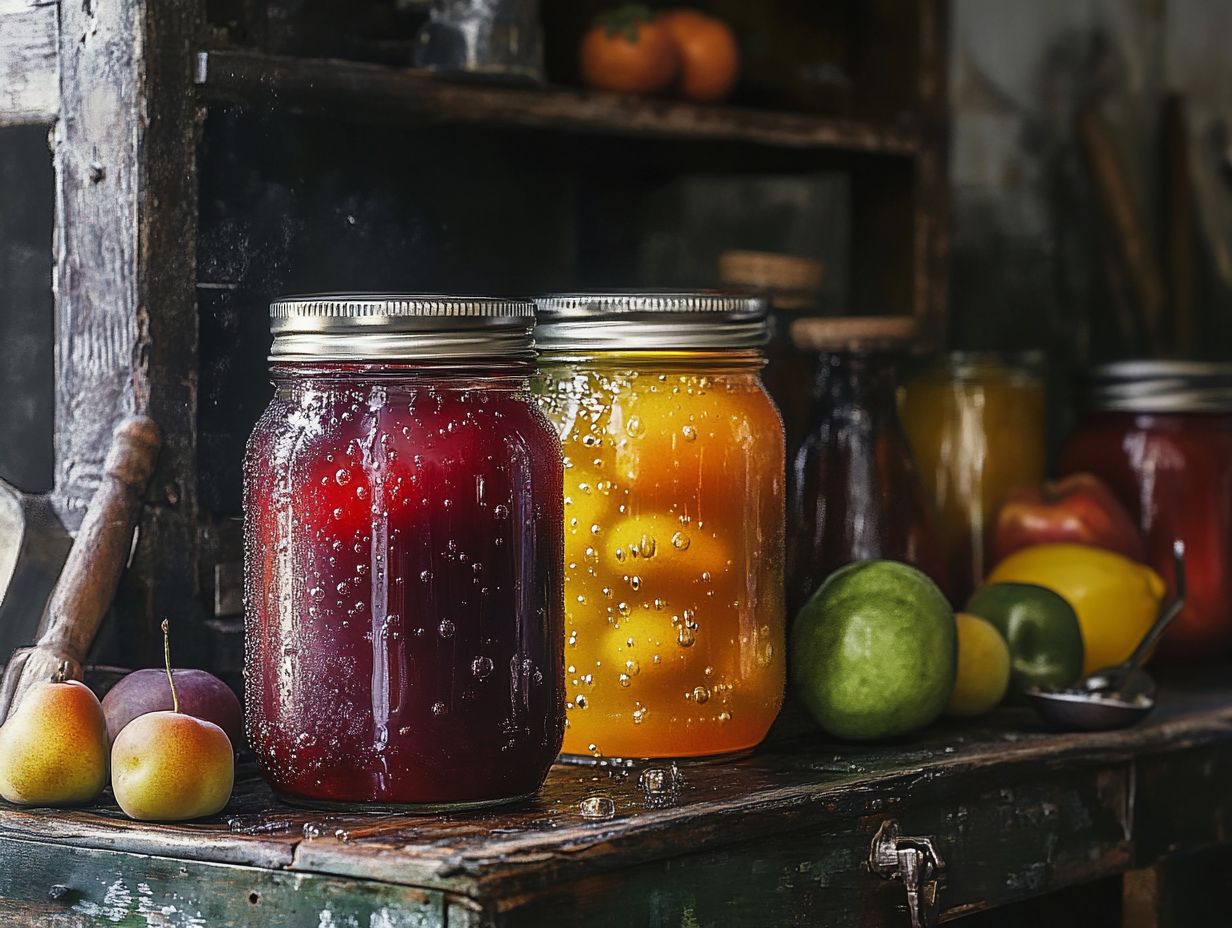
The main cause of the loss of liquid during canning is heat. As the jars are boiled or processed in a pressure canner, the heat turns the liquid into steam, causing it to escape the jar.
Can I prevent liquid loss during canning?
Yes! There are a few methods you can use to prevent liquid loss.
One method is to leave more headspace in the jar before sealing it. Headspace is the space between the top of the food and the lid of the jar, allowing room for expansion. You can also use a lid with a rubber gasket for a tighter seal.
How much headspace should I leave in a jar to prevent liquid loss?
The recommended headspace for canning is typically 1/4 inch to 1 inch, depending on the type of food being canned. For foods with high liquid content, aim to leave 1 inch of headspace to prevent liquid loss.
What can I do if my canning jars have lost too much liquid during the process?
If your jars have lost a significant amount of liquid, act quickly! You can try adding more liquid to the jars before reprocessing. For home-canned fruit products, be cautious not to overfill the jars, as this can lead to improper sealing and potential spoilage.
How can I fix a jar that has lost liquid after processing?
If you notice a jar has lost liquid after processing, gently tip the jar while it is still hot to redistribute the remaining liquid. Alternatively, use a ladle to add more liquid to the jar before sealing it.
Can I reuse jars that have lost liquid during canning?
Don’t reuse jars that have lost liquid during canning! They might not seal properly and could spoil your food. It’s best to discard the jar and use a new one for your next canning project.

